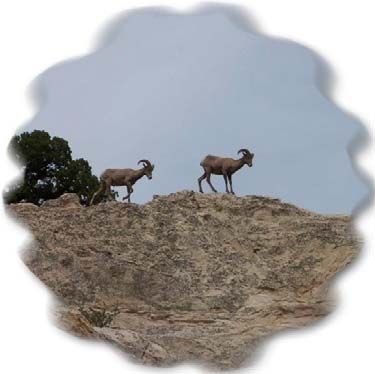Need for Sure Footed Leaders

In particularly challenging times, a good leader is essential. In the frontier days, the Scout was used to look ahead to find a path wide enough for the wagon train, to find water enough to take care of the horses, cows, and oxen. The scout also mapped out the path that would avoid dangerous areas. The scout creates confidence for the Wagon Train Master and the rest of the travelling community. Even in the animal community, there are scouts and leaders.
Pathways are not always clear, and they are not always easy. Some require training and special techniques. Rocky, steep, and uncertain trails require thoughtful observation and careful analysis, sometimes some engineering skills to cross the more dangerous places. Rocky Mountain sheep have specific skills that make them good leaders in these treacherous conditions!
This is one of the reasons that prospectors and cargo wagon trains on the Santa Fe Trail used mules. Mules are resilient, they are surefooted and they are determined! They don’t have the same fears that horses have. Mules can make good leaders over rough terrain. In the early 20th century, the train had become the go to carrier for people and for cargo. So in a way it also becomes a leader. However, creative minds and problem solvers were needed to design the strategies, do the planning and the engineering needed to navigate through the mountains and the cliffs.
IMAGES FOR EFFECTIVE LEADERS
Currently, career and life pathways are fraught with financial and marketplace and political challenges that put roadblocks, treacherous cliffs, and shale slides in our path. It is up to us to navigate and to be insistent on plotting a path. An effective leader needs a variety of qualities. Here are some take -aways from the scenarios above:
Scout: The modern day scout is a networker. This means that you tap into sources where you can see and be seen by people who can help you identify where you might find opportunities. Much of this is done through networking organizations like Linked In or through professional societies at the local and even national level. Here you would also need to be willing to invest in those organizations by participating in leadership roles. Or, you could share your skills through Linked In workshops, videos on You Tube, or even by creating a website that features your 4 primary skills. The objective is to get noticed.
It is still customary to participate in these events in person, even if that means by Zoom or Facetime. Conduct short investigative interviews with people you met, to learn what they did, why they liked their job, how they prepared for the hiring process, and what brought them to a particular company. This allows you to really get to know various people, learn from them and also to keep track of the landscape they are presenting you. Think about what you can do for the people you meet.
Mule: Being stubborn and surefooted means that you will need to know what your values and goals are. The mule will not do things it doesn’t want to do, so you as the rider have to figure out ways to convince the mule to go your way. You have to create a vision of yourself doing something and being somewhere. Having a vision that include the why in the picture allow you to not only set milestones for achieving your goal, but also to raise your awareness so that you don’t miss out on an important opportunity. Understanding your situation (i.e. the mule) will help you to avoid unwelcome pitfalls! Knowing yourself, your emotional, mental, physical, social and spiritual priorities (values and goals) can help you be surefooted in your journey on this path.
Rocky Mountain Sheep: Nimbleness is key for navigating the danger zones and for managing the risks. It is unlikely that these sheep spend time worrying about at the bottom of the canyon that drops off 3 feet away! They do not get distracted along the way. They keep moving toward their goal. They move their feet one step at a time, and they plant each foot before lifting the next one. This type of deliberateness is important in creating your own path. It is great to dream with your heart, but you will not succeed if you don’t engage your strategic thinking and your ability to be creative in solving problems.
Train: A train always has a destination! The tracks lay out the pathway to get to the destination. And the train itself, with its heavy iron wheels and cow catcher on the front makes short work of most obstacles. These added capabilities allow the train to travel unimpeded through many areas. There are, of course still obstacles like fallen trees and fallen boulders, gravel and rocks. The brakes provide stopping power when danger nears. So what are your heavy iron wheels and cow catcher? What are your brakes? And, where are these tracks taking you! The people in the train have faith that the train will follow the tracks to its destination. We also need to have faith in the tracks the Creator lays out for us to follow—if we are paying attention!



